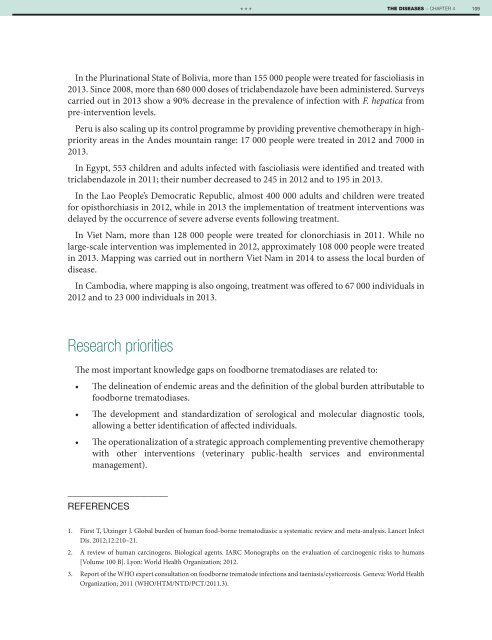1A9bnbK
1A9bnbK
1A9bnbK
You also want an ePaper? Increase the reach of your titles
YUMPU automatically turns print PDFs into web optimized ePapers that Google loves.
***<br />
THE DISEASES − CHAPTER 4<br />
109<br />
In the Plurinational State of Bolivia, more than 155 000 people were treated for fascioliasis in<br />
2013. Since 2008, more than 680 000 doses of triclabendazole have been administered. Surveys<br />
carried out in 2013 show a 90% decrease in the prevalence of infection with F. hepatica from<br />
pre-intervention levels.<br />
Peru is also scaling up its control programme by providing preventive chemotherapy in highpriority<br />
areas in the Andes mountain range: 17 000 people were treated in 2012 and 7000 in<br />
2013.<br />
In Egypt, 553 children and adults infected with fascioliasis were identified and treated with<br />
triclabendazole in 2011; their number decreased to 245 in 2012 and to 195 in 2013.<br />
In the Lao People’s Democratic Republic, almost 400 000 adults and children were treated<br />
for opisthorchiasis in 2012, while in 2013 the implementation of treatment interventions was<br />
delayed by the occurrence of severe adverse events following treatment.<br />
In Viet Nam, more than 128 000 people were treated for clonorchiasis in 2011. While no<br />
large-scale intervention was implemented in 2012, approximately 108 000 people were treated<br />
in 2013. Mapping was carried out in northern Viet Nam in 2014 to assess the local burden of<br />
disease.<br />
In Cambodia, where mapping is also ongoing, treatment was offered to 67 000 individuals in<br />
2012 and to 23 000 individuals in 2013.<br />
Research priorities<br />
The most important knowledge gaps on foodborne trematodiases are related to:<br />
• The delineation of endemic areas and the definition of the global burden attributable to<br />
foodborne trematodiases.<br />
• The development and standardization of serological and molecular diagnostic tools,<br />
allowing a better identification of affected individuals.<br />
• The operationalization of a strategic approach complementing preventive chemotherapy<br />
with other interventions (veterinary public-health services and environmental<br />
management).<br />
_____________________<br />
REFERENCES<br />
1. Fürst T, Utzinger J. Global burden of human food-borne trematodiasis: a systematic review and meta-analysis. Lancet Infect<br />
Dis. 2012;12:210–21.<br />
2. A review of human carcinogens. Biological agents. IARC Monographs on the evaluation of carcinogenic risks to humans<br />
[Volume 100 B]. Lyon: World Health Organization; 2012.<br />
3. Report of the WHO expert consultation on foodborne trematode infections and taeniasis/cysticercosis. Geneva: World Health<br />
Organization; 2011 (WHO/HTM/NTD/PCT/2011.3).


